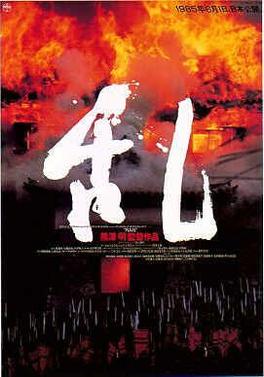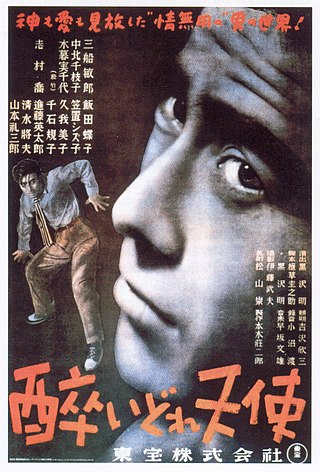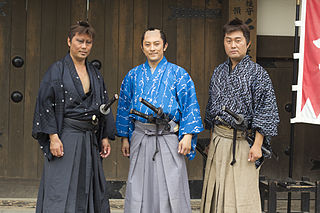Related Research Articles

Akira Kurosawa was a Japanese filmmaker who directed 30 films in a career spanning over five decades. He is widely regarded as one of the greatest and most influential filmmakers in the history of cinema. Kurosawa displayed a bold, dynamic style, strongly influenced by Western cinema yet distinct from it; he was involved with all aspects of film production.

The cinema of Japan, also known domestically as hōga, has a history that spans more than 100 years. Japan has one of the oldest and largest film industries in the world; as of 2021, it was the fourth largest by number of feature films produced. In 2011, Japan produced 411 feature films that earned 54.9% of a box office total of US$2.338 billion. Films have been produced in Japan since 1897.

Seven Samurai is a 1954 Japanese epic samurai action film directed by Akira Kurosawa from a screenplay co-written with Shinobu Hashimoto and Hideo Oguni. Taking place in 1586 in the Sengoku period of Japanese history, it follows the story of a village of desperate farmers who seek to hire samurai to combat bandits who will return after the harvest to steal their crops.

Ran is a 1985 epic historical action drama film directed, co-written, and edited by Akira Kurosawa. The plot derives from William Shakespeare's King Lear and includes segments based on legends of the daimyō Mōri Motonari. The film stars Tatsuya Nakadai as Hidetora Ichimonji, an aging Sengoku-period warlord who decides to abdicate as ruler in favor of his three sons.

Throne of Blood is a 1957 Japanese jidaigeki film co-written, produced, edited, and directed by Akira Kurosawa, with special effects by Eiji Tsuburaya. The film transposes the plot of English dramatist William Shakespeare's play Macbeth (1606) from Medieval Scotland to feudal Japan, with stylistic elements drawn from Noh drama. The film stars Toshiro Mifune and Isuzu Yamada in the lead roles, modelled on the characters Macbeth and Lady Macbeth.

Toshiro Mifune was a Japanese actor and producer. The recipient of numerous awards and accolades over a lengthy career, he is widely considered one of the greatest actors of all time. A leading figure in the Japanese film industry, he often played hypermasculine characters and was noted for his physical presence and commanding screen presence.

Rashomon is a 1950 Japanese jidaigeki film directed by Akira Kurosawa from a screenplay he co-wrote with Shinobu Hashimoto. Starring Toshiro Mifune, Machiko Kyō, Masayuki Mori, and Takashi Shimura, it follows various people who describe how a samurai was murdered in a forest. The plot and characters are based upon Ryūnosuke Akutagawa's short story "In a Grove", with the title and framing story taken from Akutagawa's "Rashōmon". Every element is largely identical, from the murdered samurai speaking through a Shinto psychic to the bandit in the forest, the monk, the assault of the wife, and the dishonest retelling of the events in which everyone shows their ideal self by lying.

Dreams is a 1990 magical realist anthology film of eight vignettes written and directed by Akira Kurosawa, starring Akira Terao, Martin Scorsese, Chishū Ryū, Mieko Harada and Mitsuko Baisho. It was inspired by actual recurring dreams that Kurosawa said he had repeatedly. It was his first film in 45 years in which he was the sole author of the screenplay. An international co-production of Japan and the United States, Dreams was made five years after Ran, with assistance from George Lucas and Steven Spielberg, and funded by Warner Bros. The film was screened out of competition at the 1990 Cannes Film Festival, and has consistently received positive reviews.

Drunken Angel is a 1948 Japanese yakuza noir film directed and co-written by Akira Kurosawa. It is notable for being the first of sixteen film collaborations between director Kurosawa and actor Toshiro Mifune.
Dodes'ka-den is a 1970 Japanese drama film directed by Akira Kurosawa. The film stars Yoshitaka Zushi, Kin Sugai, Toshiyuki Tonomura, and Shinsuke Minami. It is based on Shūgorō Yamamoto's 1962 novel A City Without Seasons and is about a group of homeless people living in poverty on the outskirts of Tokyo.
Structural film was an avant-garde experimental film movement prominent in the United States in the 1960s. A related movement developed in the United Kingdom in the 1970s.

Chanbara (チャンバラ), also commonly spelled "chambara", meaning "sword fighting" films, denotes the Japanese film genre called samurai cinema in English and is roughly equivalent to Western and swashbuckler films. Chanbara is a sub-category of jidaigeki, which equates to period drama. Jidaigeki may refer to a story set in a historical period, though not necessarily dealing with a samurai character or depicting swordplay.
The films of Japanese director Akira Kurosawa have had a far-reaching impact on cinema and how it is produced, both within Japan and internationally. As a result of his influence, Kurosawa's work, as well as his personal character, have been subject to a number of negative criticisms. These criticisms are points of heated debate among those who study Kurosawa's work, and scores of pieces have been written both advocating for these criticisms and defending against them.

Kajirō Yamamoto was a Japanese film director, screenwriter, and actor who was known for his war films and comedies and as the mentor of Akira Kurosawa. The combined list of his efforts as a director for documentaries, silent, and sound films includes over 90 film titles during his lifetime.
Lou Lombardo was an American filmmaker whose editing of the 1969 film The Wild Bunch has been called "seminal". In all, Lombardo is credited on more than twenty-five feature films. Noted mainly for his work as a film and television editor, he also worked as a cameraman, director, and producer. In his obituary, Stephen Prince wrote, "Lou Lombardo's seminal contribution to the history of editing is his work on The Wild Bunch (1969), directed by Sam Peckinpah. The complex montages of violence that Lombardo created for that film influenced generations of filmmakers and established the modern cinematic textbook for editing violent gun battles." Several critics have remarked on the "strange, elastic quality" of time in the film, and have discerned the film's influence in the work of directors John Woo, Quentin Tarantino, Kathryn Bigelow, and the Wachowskis, among others. While Lombardo's collaboration with Peckinpah lasted just a few years, his career was intertwined with that of director Robert Altman for more than thirty years. Lombardo edited Altman's 1971 film McCabe & Mrs. Miller (1971), which had "a radical approach to the use of dialogue and indeed other sound, both in and beyond the frame." Towards the end of his career Lombardo edited Moonstruck (1987) and two other films directed by Norman Jewison. While his editing is now considered "revolutionary" and "brilliant", Lombardo was never nominated for editing awards during his career.
A list of books and essays about Akira Kurosawa:
Stephen Robert Prince was an American film critic, historian and theorist. He was a Professor of Communication Studies and was a Professor of Cinema at Virginia Polytechnic Institute and State University. His books include The Warrior's Camera: The Cinema of Akira Kurosawa (1991) and Savage Cinema: Sam Peckinpah and the Rise of Ultraviolent Movies (1998). Prince was frequently cited as an expert in East Asian cinema by Criterion and can often be heard in commentary tracks in their collections.
Sōjirō Motoki was a Japanese filmmaker who served primarily as a film producer, but also as a writer and director. He was most famous for producing several films for Akira Kurosawa, including Seven Samurai, Ikiru and Throne of Blood. He also produced films for other directors, including Mikio Naruse, for whom he produced Spring Awakens and Battle of Roses, and Kazuo Mori, for whom he produced Vendetta for a Samurai. As a writer, he provided the story for Kei Kumai's 1968 film The Sands of Kurobe, starring Kurosawa favorite Toshiro Mifune.

The legacy of filmmaking technique left by Akira Kurosawa (1910–1998) for subsequent generations of filmmakers has been diverse and of international influence beyond his native Japan. The legacy of influence has ranged from working methods, influence on style, and selection and adaptation of themes in cinema. Kurosawa's working method was oriented toward extensive involvement with numerous aspects of film production. He was also an effective screenwriter who would work in close contact with his writers very early in the production cycle to ensure high quality in the scripts which would be used for his films.
The Films of Akira Kurosawa is a 1965 academic book by Donald Richie, published by University of California Press. It discusses the films of Akira Kurosawa.
References
- Bernardi, Joanne R. (1991). "The Warrior's Camera: The Cinema of Akira Kurosawa". Monumenta Nipponica . 46 (4). Sophia University: 574–577. doi:10.2307/2385205. JSTOR 2385205.
- Nolletti, Arthur Jr (1992). "The Warrior's Camera: The Cinema of Akira Kurosawa . Stephen Prince". Film Quarterly . 45 (4): 67-69. doi:10.2307/1212894. JSTOR 1212894.